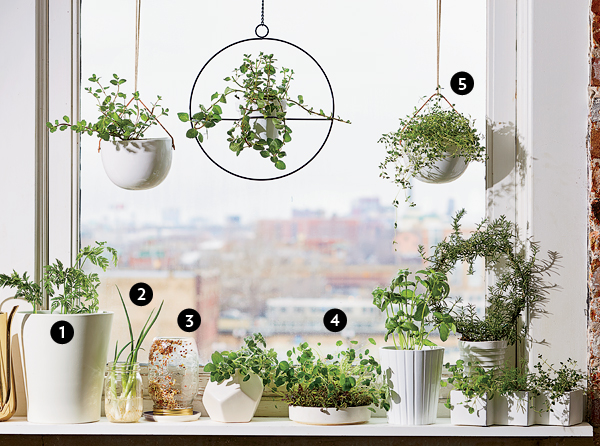
No outdoor space? No problem. There’s a huge range of herbs and vegetables that thrive on a sill. Choose a south-facing window if you can, ideally one that gets at least six hours of sunlight in the summer. Use potting soil, not gardening mix, and non–terra cotta containers that have drainage holes. (Place a saucer underneath to catch any water that makes it through.) And be sure to give your plants a quarter-turn every few days.
1. Carrots
Most indoor gardeners don’t think of growing root vegetables, but carrot varieties like Nantes and Romeo do well in containers. Make sure to use a deep enough pot (six inches for Romeo, 10 for Nantes). Water often in small amounts; soil should stay moist to the touch.
2. Green onions
Growing scallions is crazy easy: Buy two or three bunches at the store, save the white bulbs (along with an inch of green stem), and pack them gently into a 12-ounce Mason jar, root side down. Fill the jar with water to cover the bulbs—no soil necessary—and in a week, voilà: You’ll have a new crop of green onions. You may even get a second or third harvest.
3. Alfalfa sprouts
Another no-soil option. Place two tablespoons of seeds in a Mason jar, add some water, swirl, and strain using a mesh screen. Refill the jar with water and let the seeds soak for eight hours or so. Strain and move the seeds to a dark corner; leave them in the jar for five days, repeating the swirling and straining twice a day. After five days, you’ll have tender sprouts.
4. Microgreens
Scatter eight to 12 seeds—we recommend Johnny’s Selected Seeds Mild Micro Mix ($5.25 at johnnyseeds.com)—per square inch in a shallow, wide tray filled with potting soil. Mist the seeds with a spray bottle twice daily (watering with a can risks disturbing the seeds). Snip the leaves when the greens are an inch tall, in about two to four weeks.
5. Herbs
Almost all popular kitchen herbs take well to indoor gardening. For staples like basil, dill, rosemary, oregano, sage, and thyme, you’ll want a pot deep enough to accommodate at least 10 inches of soil. Plant as seedlings, and water when soil is dry to the touch.

The Dirt on Soil
For containers
Buy potting soil, not outdoor gardening mix. It contains a denser concentration of bark, peat moss, compost, humus, and minerals like perlite, and it’s fluffier, which keeps it from compacting after repeated watering. Avoid potting soil premixed with pesticides, which can contaminate your fruits and vegetables.
For raised beds
Look for garden soil formulated for vegetables in raised beds, not soil labeled for in-ground planting. Miracle-Gro Nature’s Care ($8 for 1.5 cubic feet) is a good choice. This kind of product is typically a mix of topsoil and organic stuff like compost and peat moss. To figure out how many cubic feet you’ll need, just measure your bed’s length, width, and height and multiply them.
What about mulch?
A top layer of wood chips in a raised bed looks pretty and will help with water retention and weed control. Free wood chip mulch is available from the City of Chicago (go to cityofchicago.org, type “wood chips” in the search bar, and click the first result), or buy some at Home Depot for $3 a bag. Cocoa bean husks have become a popular mulch, too, partly because they smell of, yes, cocoa. You can get a bag at Menards ($6.50 for 2 cubic feet).
And compost?
Though many kinds of garden soil include compost as part of the mix, add more to boost soil nutrients and water retention. If you don’t make your own, buy a bag of composted manure at Menards ($2.50 per .75 cubic feet). Sprinkle a thin layer over your soil mix.


